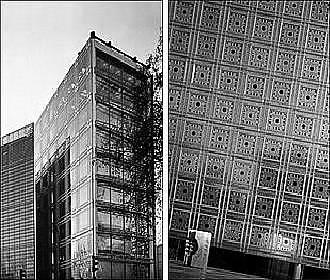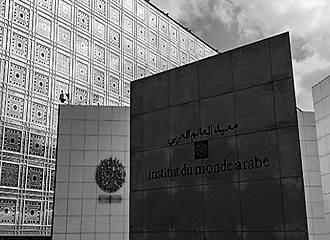Paris Institut du Monde Arabe History and Building
The Institut du Monde Arabe or IMA for short is also known as the Arab World Institute in English, and located on the banks of the River Seine, it is a cultural centre with an innovative building construction, that has proven to be a great success with locals and tourists.
Paris Institut du Monde Arabe Beginnings
It all started at the beginning of the 1980s when the French President and around 18 Arab countries entered an agreement together to exchange science and technology and promote a cultural relationship between France and the Arab Nations.
And so the idea of an Arab Institute in Paris was born, and aimed at being one of the grand design projects for the capital city, a design competition was launched for the design and construction of a new cultural centre.
The project was won by Jean Nouvel and the AS Architecture-Studio with an innovative use of technology within the design of the building, which was based upon an effect often used in Islamic architecture, but this meant having to overcome new boundaries, that have since been replicated in other buildings.
Paris Institut du Monde Arabe History
And so, work started in 1981 on the building for the Paris Institut du Monde Arabe cultural centre.
Spread over an area of approximately 27,000 metres squared and a building size of approximately 16,500 metres squared, the facade along the River Seine is curved the same way as the river, whereas on the other side, which has the immense courtyard, the facade is straight, and this area is also now the home of the Chanel Mobile Art centre, but that is an entirely different story.
You see, on this side it is the rectangular straight glass clad wall that faces the courtyard which utilises innovative technology, and became its most prominent success point that meant the Aga Khan Award of Architecture was awarded for its design concept.
The innovative technology for the building was based upon an effect of filtering light for climate, which is often used in Islamic architecture and therefore, behind this modern glass wall of the building there are metallic diaphragms acting like a metallic screen.
There are approximately 240 of these moving geometric photo-sensitive apertures that are motor-controlled and act like a shutter lens on a camera that can open and shut to allow more or less light and therefore heat, into the Paris Institut du Monde Arabe building from the sun.
So, as you can no doubt imagine, the interior of the building tends to change its appearance and this element of the design can be seen easier from the inside, but if you are really lucky, you may be able to see the ocular devises actually move on the outside when the sun goes behind clouds, etc.
Eventually, in 1987, the project was complete and inaugurated by the French President, Francois Mitterrand in the company of many foreign dignitaries, and it was first opened to the public in the December of that year.
And having proved to be a continual success, not only for the cultural centre, but also the use of smart materials for the building, which has led to numerous other buildings throughout the world being constructed along similar lines, the Paris Institut du Monde Arabe has continually expanded and promoted the cultural relationship between France and Arab Nations.


